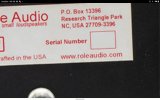This is a review, listening tests, EQ, and detailed measurements of the Role Audio Skiff compact speaker. It is on kind loan from a member and costs US $495 to $545 a pair depending on finish.

Can't say there is much to look at especially since the grill is glued/screwed on and can't be removed. It is stated (I think) that it is a single 3" driver with no crossover. Enclosure is 4x6 inches and 5 inches deep -- so quite compact. Back panel shows nothing exciting:

Speaker came out circa 2000s but it is still being manufactured and sold.
Role Skiff Speaker Measurement
As usual, we start with our anechoic frequency responses:

I expect issues with single drivers and we have them here. There are no less than four very pronounced resonances. What I can't figure out is why there is a directivity error where there would normally be a crossover to a tweeter. I would have expected the directivity index to keep going up, not dip down.
Early window reflections are not pretty:

As a result, predicted in-room response suffers as well:

Speaker started to make odd sounds and compress, getting distorted before I could get up to 86 dBSPL. So I settled on testing it at 80 and 83 dBSPL when it came to distortion:


Beamwidth is highly variable, as is directivity in both axis:



Impedance is above average at 7.7 ohm:

The flat response to DC indicates no high pass for the little woofer. This may be the reason I was hearing severe distortion at the start of sweeps at higher SPLs.
Waterfall shows clear resonances:

Here is our step function:

Does this indicate one or two drivers? There seems to be a second blip.
Role Skiff Speaker EQ and Listening Tests
First impression was kind of screechy so out came the EQ:

Yes, it is by far more filters than I have ever deployed in a speaker. Despite the quantity, the difference is subtle since I left broad areas intact. The immediate difference with EQ is better clarity and more balanced sound. With the filters in place, I say about 40% of my tracks were listenable and pleasant. Anything with bass would upset the applecart as you can imagine. I performed a lot of tuning in bass and midrange response and got what you see.
Sensitivity of the speaker is quite low so took a lot of power to drive. At the same time, there is a cliff after which distortion sets in.
Conclusions
Once again we have a manufacturer wanting to break the laws of physics. I say they seem to have a decent driver as far as power capability is concerned but otherwise, the concept fails in frequency response as the driver breaks up/resonates. With power of eq we can salvage what is there but I can't see a reason to make it worthwhile unless you really needed such a small speaker.
I can't recommend the Role Audio Skiff.
Manufacturer Specifications:
Single-way compact loudspeaker.
3.5" magnetically shielded paper cone full-range driver.
Rated frequency response: 125Hz - 20kHz (-6dB).
Impedance: 8 Ohms nominal (min. 6.5 Ohm).
Efficiency: 88dB 1 watt/m.
6" x 4" x 5", 3.51bs each.
-----------
As always, questions, comments, recommendations, etc. are welcome.
Any donations are much appreciated using: https://www.audiosciencereview.com/forum/index.php?threads/how-to-support-audio-science-review.8150/
Can't say there is much to look at especially since the grill is glued/screwed on and can't be removed. It is stated (I think) that it is a single 3" driver with no crossover. Enclosure is 4x6 inches and 5 inches deep -- so quite compact. Back panel shows nothing exciting:
Speaker came out circa 2000s but it is still being manufactured and sold.
Role Skiff Speaker Measurement
As usual, we start with our anechoic frequency responses:
I expect issues with single drivers and we have them here. There are no less than four very pronounced resonances. What I can't figure out is why there is a directivity error where there would normally be a crossover to a tweeter. I would have expected the directivity index to keep going up, not dip down.
Early window reflections are not pretty:
As a result, predicted in-room response suffers as well:
Speaker started to make odd sounds and compress, getting distorted before I could get up to 86 dBSPL. So I settled on testing it at 80 and 83 dBSPL when it came to distortion:
Beamwidth is highly variable, as is directivity in both axis:
Impedance is above average at 7.7 ohm:
The flat response to DC indicates no high pass for the little woofer. This may be the reason I was hearing severe distortion at the start of sweeps at higher SPLs.
Waterfall shows clear resonances:
Here is our step function:
Does this indicate one or two drivers? There seems to be a second blip.
Role Skiff Speaker EQ and Listening Tests
First impression was kind of screechy so out came the EQ:
Yes, it is by far more filters than I have ever deployed in a speaker. Despite the quantity, the difference is subtle since I left broad areas intact. The immediate difference with EQ is better clarity and more balanced sound. With the filters in place, I say about 40% of my tracks were listenable and pleasant. Anything with bass would upset the applecart as you can imagine. I performed a lot of tuning in bass and midrange response and got what you see.
Sensitivity of the speaker is quite low so took a lot of power to drive. At the same time, there is a cliff after which distortion sets in.
Conclusions
Once again we have a manufacturer wanting to break the laws of physics. I say they seem to have a decent driver as far as power capability is concerned but otherwise, the concept fails in frequency response as the driver breaks up/resonates. With power of eq we can salvage what is there but I can't see a reason to make it worthwhile unless you really needed such a small speaker.
I can't recommend the Role Audio Skiff.
Manufacturer Specifications:
Single-way compact loudspeaker.
3.5" magnetically shielded paper cone full-range driver.
Rated frequency response: 125Hz - 20kHz (-6dB).
Impedance: 8 Ohms nominal (min. 6.5 Ohm).
Efficiency: 88dB 1 watt/m.
6" x 4" x 5", 3.51bs each.
-----------
As always, questions, comments, recommendations, etc. are welcome.
Any donations are much appreciated using: https://www.audiosciencereview.com/forum/index.php?threads/how-to-support-audio-science-review.8150/
Attachments
Last edited:





